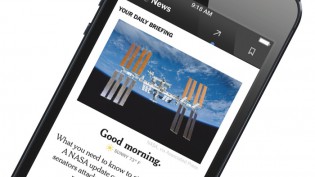Newsonomics: 10 Numbers on The New York Times’ 1 million Digital-Subscriber Milestone
If, half a decade ago, you’d been able to put money down in Vegas on The New York Times’ chances of reaching 1 million digital subscribers by 2015, what kind of odds could you have gotten? Longer than longshot. In 2010, when the Times announced it would put up a paywall, hardly anyone thought readers would pay for that sort of “commodity” — general news — on the web. TimesSelect, the Times’ first foray into digital paid content in the mid-2000s, had gone bust, and the program’s name served as an easy punchline for the conventional wisdom of the moment.
Today, four and a half years after the Times introduced its metered paywall, we can declare a milestone. The Times can now count 1 million digital-only subscribers. It’s a moment the Times should be celebrating. And yet, despite this success, the Times’ ad results paralleled too closely that of its peer newspaper companies. For the quarter, overall ad revenues dropped 5.5 percent, anchored down by a print loss of 12.8 percent despite a digital gain of 14.2 percent. That means overall revenues dipped 1.5 percent. The outlook for the third quarter: another “decrease in the mid-single digits” in overall ad revenue. None of that is surprising; it’s largely more of the same, with a deeper print gloom to consider.
For today, though, let’s pull apart the million-reader milestone. It’s worth celebrating for all who value journalism.
First published at Harvard’s Nieman Journalism Lab
Follow Newsonomics on Twitter @kdoctor
Ironically, almost all of the Times’ top leadership that put the metered paywall into place — save its owners — are gone. The next generation of Times execs faces this question: What do we build on top of the paywall? The paywall didn’t “save the Times,” but it’s come damn near close. This year, digital-only reader revenue will reach close to $200 million. And though print circulation continues to shrink, there’s little doubt it would have dropped more quickly if print subscribers had continued to be confronted with what now seems like a crazy paradox: Pay hundreds of dollars for a print Times — or get all the content free not only online, but on that smartphone and tablet that have become third and fourth arms of our lives.
One million acts as a threshold number. Let’s plumb what it means, looking at 10 related numbers that flesh out its meaning.
1. Readers reward elite global journalism.
The Times can claim first place with the million. The Wall Street Journal is close behind, at 900,000, while the FT’s digital subscription number stands at 520,000. These solid numbers form bedrock for the future. For news companies, being national now means being global, and being global means enjoying unprecedented reach. These audiences of a half-million and more portend more reader revenue to come.
2. Digital-only news readers about pay for the cost of the newsroom.
If we figure an average all-in cost per full-time Times journalist at $150,000 and throw in extensive travel and related costs, we can estimate a budget of $200 million a year. That’s assuming that, with the rehiring the Times has done post-2014 buyout, it now houses close to 1,300 journalists. Digital-only readers will add about $185 million to the coffers this year. Of course, the digital subscription system costs money, to build and to operate. But the rough equivalency offers a tantalizing questions: Could readers directly pay for voluminous, high-quality journalism?
The short answer: No. The Times’ greater recent success owes a lot to its steady integration of dozens if not hundreds of technologists into the news process. News tech is becoming irrevocably intertwined with journalism, at everywhere from the Times to Vox, Vice, and BuzzFeed. Then there’s the growing marketing and audience development costs required to operate a winning digital business, which aren’t minimal. So the equivalency might get our juices going, but it only starts the digital-only conversation for the future.
3. Mobile engagement drives much of the digital subscriber business.
According to data from the Times, almost a quarter of its iPhone app’s monthly users are subscribers. While 30× more Times unique visitors access the Times through a mobile browser than through its app, it’s the subscribers who disproportionately love the app. Love = engagement, with about three times more pages consumed on apps than through browsers. The iPad app elicits similar behavior.
The Times has smartly built out its suite of products to allow its frequent readers to move, with less effort, from desktop to smartphone to tablet and back. Yet its that mobile utility and convenience — largely through the app — that drives much of the subscriber satisfaction.
4. The Times can count about the same number of paying daily readers today as it could in 1995.
In those pre-digital days, the Times’ daily circulation stood at 1.5 million. Today, it counts 625,000 daily print payers (home delivery and single copy) and those 1 million digital payers. That’s a little over 1.6 million. That’s another mind-boggling equivalency. With all that has changed, in the news business particularly, roughly the same number of people pay for The New York Times. One takeaway: Even at the peak of financial success — and the ’90s were good for the industry — the Times still relied on only a tiny percentage of Americans. At one point, a million and a half paying readers meant sustaining prosperity. Now, it seems like a shaky lifeline. There’s truth and there’s perception, and a lot to think about.
5. Only a small percentage of Times readers generate a huge part of its income.
The Times generates about 60 million unique visitors (U.S.) a month. One million of them pay; 59 million don’t. That’s less than two percent. The rest of the digital audience supplies attention which the Times monetizes through advertising, but then again it’s those one million paying readers who consume a greater slice of the pageviews, doubling their value. It’s the more 1.15 million print payers who are responsible for all the print reader revenue — and all the print ad revenue. So we can safely say that the business — today’s and tomorrow’s — is built on a narrow slice of people who consume Times content in any given month. That’s not a problem — it’s just a realization for all digital news companies. Loyal core readers build the foundation of the new business.
On Sunday, the 1.15 million paying print readers mean that the Times can count more than 2 million total paying customers (adding in those million digital-onlies). Is 3 million an achievable goal at some point? That’s the target that Dow Jones CEO Will Lewis has set for The Wall Street Journal.
6. The Times’ crossover grows more profound.
Revenue from readers — print and digital — now stands at 55 percent of all revenue. Advertising revenue makes up 39 percent. That crossover works to the Times’ advantage. As advertising continues to absorb losses, its decline is minimized by the fact that the Times is not as reliant on ad revenue as it once was. The Times reader/ad ratio is the flipside of most dailies, who still count on ad dollars for most of their revenue.
7. Zero remains a number of achievement.
8. The global opportunity rises in importance.
Reliably, 12 to 13 percent of digital subscriber growth arrives from outside the U.S. That means the non-U.S. digital subscriber population is approaching 100,000. Expect 2016 to see a major focus, and an investment, on moving well past that number.
9. Newsroom investment is a business driver.
Of the Times’ total expense budget, about 20 percent goes to the newsroom. That’s about one-third more than the average U.S. daily, which spends 12.5 percent — or one out of eight dollars — on content creation. It’s no accident that the two regional leaders in digital-only sales, The Boston Globe (with 63,000 digital-only subscribers) and the Star Tribune in Minneapolis (with 58,000 digital-onlies), both spend closer to 20 percent as well. Readers know quality, depth, and breadth when they see it, and they’re willing to pay for it. There’s a lesson in that for the industry.
10. Paywalls 2.0 still waits in the wings.
NYT Now, launched in April of last year and made free in May of this year, failed at its original goal: to find a new younger, paying audience with niche under-$10-a-month products. There’s no doubt NYT Now has influenced current mobile presentation and story choice. But the question still hangs in the air, for the Times and the wider industry: Other than full-priced subscriptions to around-the-clock firehose of NYT content, what will anyone pay for?
NYT Now found 20,000 new subscribers before it went free. Can the Times turn its popular Cooking app into a reader revenue source? What else might generate new reader payment — sports, health, travel? Expect new experimentation in 2016. Paywalls 1.0 — even with the 1 million number — can only take the Times so far; it needs to find additional spigots of reader revenue to get past flat revenue and into growth.
Alternatively, we may see differing spins on low-cost “newspaper” subscriptions. Jeff Bezos’ Washington Post brings Amazon-like thinking to subscription pricing (“Is The Washington Post closing in on the Times?”), offering subs for as low as $19 for a full year. The Post would need a huge buyer multiple to make a business model out of that number. But at this point, the more product and price experimentation, the better.







